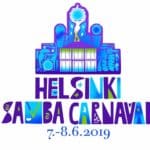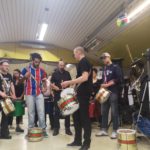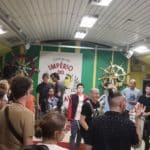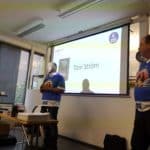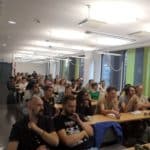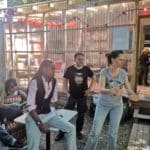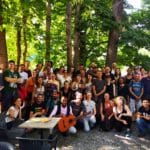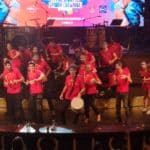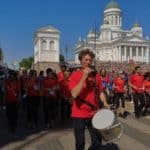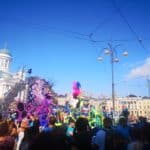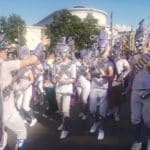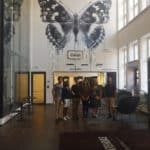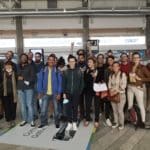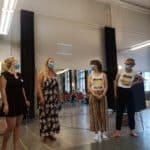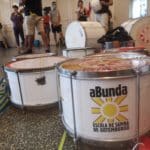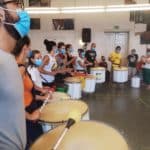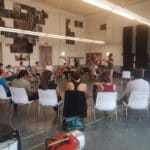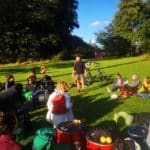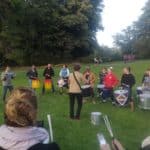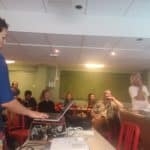

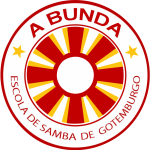
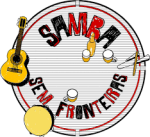
Erasmus+ program
KA1 – Adult education
Coordinator
Manufacturers of multicultural cooperation spaces
"Builders of multicultural cooperation spaces" is a cooperation between four European structures that use samba (a musical genre originating in Brazil) to carry out creative, social and civic actions. The cooperation aims to develop the artistic and managerial skills of the personnel involved in order to consolidate and amplify the sambist networks in France and Europe.
Three learning mobilities will be set up to meet very specific objectives:
• Deepen artistic skills and broaden the multidisciplinary spectrum of partners' activities;
• Train and design tools to structure and grow European sambist networks;
• Question the fusion of Brazilian culture with the cultures of the North to draw inspiration from it and promote intercultural engagement.
This program will allow us, in close collaboration with our partners:
• To create a common repertoire and disseminate newly acquired artistic skills;
• Publish an inventory of existing networks and draw up a list of actions to be put in place to foster partnerships and good practices;
• To share adaptations of Brazilian culture by the four partner countries.
Art and culture are seen here as tools for social cohesion, personal fulfillment and international opportunities, as well as a major component of the European economic sector. The project shares the vision of the European Union by considering the creative sector as "an essential tool for emerging from the crisis" in the 2020 strategy for smart, sustainable and inclusive growth.
Partners

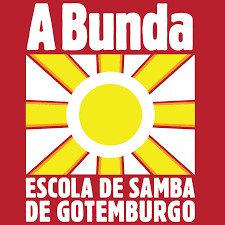
In 2007 a delegation of 12 A Bundistas took part in the 2nd International Encontro do Samba at the Cidade do Samba in Rio, performing together with members of Curicica and Monobloco, and also paraded through the Sambodromo among the 2500 participants of União do Parque Curicica, the final group appearing at the last night of the Carnival.
A Bunda took an active part in the first three European Encontros do Samba in Uppsala 1986, Åbo 1987 and London 1989, arranged and hosted the fourth Encontro in Gothenburg 1997 (with 600 participants from many different countries) and participated with a large delegation in the fifth Encontro in Villeneuve-Sur-Lot 1999 organised by Samba Résille.

The activities of the group are multiple and cover:
-Musical creation and production: 2018 was the year of preparation and launch of the group’s first original album, already in preparation for a second job.
-Dissemination: in recent years, the group has traveled the country from north to south with live performances, festivals, municipal parties, private and corporate events.
Training at local and international level, such as those carried out with Samba Résille in 2019 and 2020.
Mobilities
From June 3 to 9, 2019
Cooperate to grow / Networks
This mobility made it possible to discuss the particularities of sambist networks in Europe and to acquire knowledge on the functioning of our Finnish partner as a federation as well as on the legitimacy and recognition that this brings to them. The design of tools aimed at consolidating existing networks was thus possible. The participants were also led to question Brazilian culture, its appropriation in Europe and the meaning of international creative cooperation, in particular thanks to their participation in the Helsinki carnival.
Activities :
• round tables on the arrival of samba in Finland and on the origins of samba in France;
• information and discussion sessions on the origins and organization of the Finnish Samba Federation and on the tools put in place to enable this networking;
• dance and percussion master classes as well as preparation workshops for the Helsinki Carnival;
• visits to samba schools outside Helsinki;
• participation in the carnival parade;
• visits to the Samba school GRES Maciera de Ouro in Talinn, Estonia;
• a meeting with the Caisa Cultural Center in Helsinki.
From August 20 to 26, 2020
Create to engage / Living arts
This second mobility follows the one organized in Helsinki and allowed us to meet our Swedish partner, A Bunda. A Bunda is one of the oldest and most important Samba schools in Europe. It was created in 1984 by a group of Swedes, who wanted to set up activities with Brazilian asylum seekers fleeing the military dictatorship of their country. It is a non-profit cultural organization, built around several poles of artistic, cultural and social activities: percussion and Brazilian dances, street theater (Bouffons characters from Comedia Del Arte), circus arts, harmony and Brazilian singing, costume design, scenography and construction of mobile sets. She acts to promote Brazilian culture and uses the carnival arts as a learning and mediation tool. It thus has extensive experience in the non-formal training of young people and adults.
This mobility consists of sharing artistic and technical skills. The participants were able to acquire a multidisciplinary learning, mixing dance, music, singing. An analysis of the fusion of cultures and its impact within our own practices was thus able to be carried out to promote intercultural commitment.
Conducted jointly by the staff of Samba Résille and its partners, the training includes:
• round tables on the arrival of Samba in Sweden and on the origins of Samba in France;
• information and discussion sessions on the dynamics of European Encontros since the very first ones in the 1980s;
• artistic workshops for stage acting and other artistic encounters;
• presentation and discussion sessions on European programs (Erasmus + in particular);
• workshops with A Bunda, Caramatu and Kiriaka.
From October 26 to November 1, 2020
This third mobility follows the one organized in Sweden and allowed us to find members of the Samba Sem Fronteiras group in Porto. After the discovery of the samba practices of our Scandinavian friends, it seemed relevant to cross the glances with actors of the Brazilian culture so that they can deliver their glance on the diffusion of the samba in Europe, but also with actors of one of the source cultures of the samba, namely the Portuguese culture.
One of the major issues of the project being the intercultural question, this overview allows the staff of Samba Résille to go further by gradually building a 360° vision of the intercultural issues related to samba, by asking the right questions to good places: what does samba represent for a Swede, a Finn, a Brazilian, a Frenchman, a Portuguese?…
From an artistic point of view, while the first two mobilities gave pride of place to the batucada, the Porto mobility is devoted to the roda de samba. Typically Brazilian, the roda is indistinctly a participatory concert space and a space for education – samba lessons not being the rule in Brazil, it is in the roda that the musicians do their apprenticeship. This device is particularly interesting to study in the context of our research on non-formal education.
Indeed, how does the roda manage to produce this harmony that seems so spontaneous and communicative, by bringing together expert musicians and other beginners, and who often did not know each other before sitting around the table?
Conducted jointly by the staff of Samba Résille and its partners, the training includes:
• courses and conferences on the advent of samba in Brazil and its dimension of Afro-Brazilian culture of resistance; on the reception of samba in Portugal.
• information and discussion sessions on the roda system.
•musical workshops on the different styles practiced in the roda.
• artistic workshops for performing on stage and other artistic encounters.
•presentation and discussion sessions on European programmes.
Testimonies
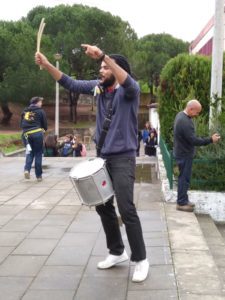
It’s by telling these mobilities to my family that I measure each time more the chance I have to go in these conditions, to discover what is being done in other countries through music.
These mobilities are also a good opportunity to discover the other members of the association (… surprise guaranteed!). It’s then possible to lean on this new complicity to enrich our musical practice when we play together in Toulouse. Once again a great mobility, waiting for the next. Kiitos!
« Virade » click in an air-raid finish shelter
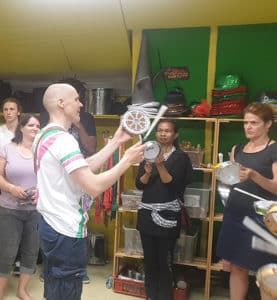
Very ideal, in 2019, to contain the sound of a bateria de samba, this place was used as an air-raid shelter for kids of a kindergarten near it. It was for protection, when the European countries were at war. We participate in a batucada master class led by Marcus, one of the leaders of Papagaio. Each one of us takes his instrument. I take a tamborim. I used to play the snare drum when I was in Samba Résille band (now I’m in the pagode group).
Papagaio plays samba carioca. This rhythm from the south of Brazil accompanies the Rio de Janeiro carnival. The tamborin are played with a fast rotation of the wrist called a “virade”. Mastering the virade distinguishes the good player of tamborim. This movement, not really worked in Samba Résille given a preference for the rhythms of the north of Brazil, always seemed to me impossible to realize.
Wishing to make a good impression in front of Marcus who is showing us the rhythm to work, I first make clumsy virades. Kindly, Marcus shows us the movement again. Then Herisao takes the time to explain that we need to anticipate the movement of the wrist, just before hitting the instrument.
And then, it’s the click! I can do it! I needed to go to Helsinki to finally understand the good movement for the tamborim, which I thought was inaccessible for me.
Well, I should stay modest. I still need to practice a lot for the movement to be written in my brain and become a reflex. But the more important part is done and I live it as a victory. I know the movement and I can repeat it whenever I want.
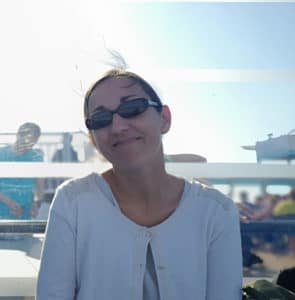
In a big disused building, in the quiet suburbs of Helsinki, men, women and children are really busy; they finalize the floats, they polish the costumes, they review the dance moves, they tune their instruments… Outside, begins the general rehearsal of Papagaio for the big parade of the carnival happening during the weekend. What we notice in this first day of the mobility, it’s the similarity with Rio, the costumes, the music style, the structure of the parade: free figures, standard-bearer, influence from Bahia, dancers, the bacteria accompanying the puxador and the cavaquinho, the “old” guard at the end… Everything is here! This carnival has, like in Rio, its king and queen, competing very seriously.
This impression of wanting to be really close to what’s happening in Rio, I will find it many times during this week, witnessing the performances of the groups during the “Noite das fantasias” on the stage of the Apollo Club, or during the rehearsal of the GRES Samba carioca in Turku. The costumes made of feathers, colors and glitters, seem to be from the Brazilian carnival. The pieces are accorded to the songs, sophisticated breaks and technically advanced variations give relief, richness and diversity. Unity of style, unity of universe… Big contrast with us, batuqueiros and batuqueiras of Samba Résille, with our “free style”, our diversity of musical types, and our freedom taken with the carnival codes. Big contrast too with the batucadas from France, where dancing and singing play a limited part. But like in every trip, impressions will be soon surpassed.
On the second day, seminar about samba in Finland and in France. Toni Ström tells its story and his desire to dedicate its life to this universe. For him, it’s a real “way of life”. All the members of its family play samba! Harri Engtrand, who had several positions in Papagaio, never missed any carnival since 1991. In Finland, samba is made by passionate people! Toni and Harri spend a lot of energy since the 90’ for their school and for the influence of samba in Finland and abroad. Here, subsidies don’t exceed 10 % of the budget, so they have to find funds, partners and solutions to rent or borrow rehearsal spaces, to pay the electricity, the security during the carnival… Every member of the school pays to parade.
On the musical side, more of passion, it’s important to talk about demand of level. On top of the rehearsals, musicians train watching Brazilian videos on Youtube. In the Turku school, a player of chocalho wrote a musicology thesis, and the tamborims participated in a workshop with a mestre from the prestigious Mangueira school in Rio. Sami Kontola, who leads one of our masterclasses, got admitted in this school, in Brazil, it was then one of the first European player to get into their bateria. And we find this desire for excellence when he asks us to play really slowly and soft to distinguish the rhythms and focus our attention on harmony. Because the demand of quality is also collective. For that matter, after each carnival, members of the schools debrief joyfully watching their performance to analyze it.
In a little waiting room in the rehearsal place in Turku, I meet Taru, florist and mother of 5 children, who spends her free time making costumes. She shows me pictures of her work: headdresses more than 3 meters high, big dickeys, a dress that she spent more than 80 hours making! Near her, Mari is gently mocking her, telling that during a diner in her house, Taru kept working on one of her piece while watching her saucepans… We understood it, on the costume side, the commitment is also impressive! Every member has to make his own, and the parents are responsible for the costume of their child. The forms and colors lean in the parade theme, determined by a committee, even if each person can bring its ideas.
This demand for quality contributes to develop strong relationships, more than a team spirit, a family spirit. In Turku again, they invite us to watch the pictures of the school, funded in 1986, and they offer us the catalogue they made for the 20th birthday of the school: extract of articles from prestigious newspapers, pictures of their participation in carnivals, but also pictures of weddings of members who met at the schools, birth announcement for the babies born of these unions… and everywhere smiles, conviviality and fun.
In the Finnish schools of samba, all the generations are present. During the rehearsals for the carnival, children help to make the costumes, follow the steps of the dancers or play with a ball. Some classes are especially made for them, led by members of the school, and they participate in the parade. Sometimes, boyfriends of the dancers, worried to see them parading lightly dressed, integrate the bateria. And like in every family, new people are coming every year, others leave, others come back or change their role, dancers become musicians, musicians help with the administrative part…
In Finland, samba is more than a copy-paste of the Rio Carnival. Style born from of mix of cultures, this music and its universe produce new cultural mixes, like a virtuous web of artistic and human inventiveness, with connections multiplying endlessly.
Because if the music uses the samba carioca codes, the songs, like the one of Papagaio “Aika” (time) are composed in Finnish. In Turku, they try to adapt the theme of the parade to the local environment. This year, the organizing committee chose the artificial intelligence, to link the carnival to the presence of many students in high technologies in the city. And even if they choose not the be politics or religious, themes around the environment were also chose in the past. Regarding the weather, it produces constraints for which they find solutions. In winter, artificial leathers are used because of the humidity and cold, while animal leathers are used for the performances.
During our visits and the masterclasses, I feel the effervescence, the pressure, and what’s at stake during the competition of the carnival. But conviviality is the key word: the desire to share musical moments, to exchange on the cultural practices from a country to another, the good mood during the rehearsals, the energy of the dance. And this is maybe the essence of samba that we can find in Samba Résille, this pleasure to be together with music, these rich relationships between individuals. Probably our part of Latinity, whether we are from France, Brazil of Finland… A universal component of humanity?
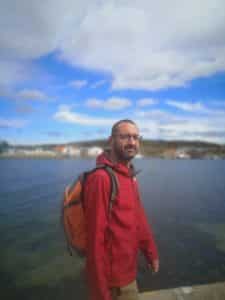
Départ à l’aube, tous masqués, le rendez-vous est fixé à Blagnac à 4h30 pour l’embarquement.
5 heures: G se rend compte qu’elle a oublié son passeport chez elle. Stress à son maximum, va-t-elle pouvoir s’envoler ?
7h30: D a perdu sa carte bleue à l’embarquement à Amsterdam… Va t’elle pouvoir manger ?
18 heures: après les présentations de Samba Résille et Abunda, notre partenaire suédois, F décide de rentrer à l’auberge. Elle prend un tram qui l’amène à l’autre bout de la ville, elle est perdue… Va-t-elle pouvoir dormir ?
21 heures : Retour de F à l’auberge après un long périple à Göteborg elle va pouvoir dormir ! La carte bleue de D a été ramassé par un passager elle va pouvoir manger ! L’ami de G lui a amené son passeport à L’aéroport, elle a pu s’envoler ! Jour 1 de la mobilité, le ton est donné, tout le monde va pouvoir se reposer après une longue première journée!!
Les journées s’enchaînent à un rythme effréné. Atelier pagode, Batucada, danse, les rencontres sont riches d’échanges et de partage. Le contact avec nos partenaires suédois est facile. De toutes les mobilités auxquelles j’ai participé, pour quelqu’un comme moi pas très à l’aise avec l’anglais, j’ai trouvé le contact facile. Les personnes rencontrées ont été très amicales et m’ont incité à communiquer, à échanger malgré mes appréhensions liées à la langue. J’ai rencontré des personnes très accessibles et désireuses d’en savoir plus sur Samba résille, mais aussi sur chacun d’entre nous individuellement.
Dans le groupe Samba Résille, une atmosphère bienveillante et joyeuse a régné tout au long du séjour, séjour qui a été ponctué d’anecdotes cocasses, de moments joyeux, de soirées festives entraînant des réveils difficiles où l’on sentait le soutien dans le regard de l’autre qu’il soit français, espagnol, bulgare, sud-américain ou suédois, dans le regard on parlait tous la même langue.
Personnellement, je donnerais une mention spéciale à Paola et Renata qui m’ont permis de découvrir et prendre un réel plaisir dans la danse. Les petits toulousains raides comme des piquets ne se sont pas démontés face à la grâce des danseuses de Abunda, Chapeau !
Cette semaine s’est déroulée au rythme de gaffes attendrissantes de chacun des membres du groupe, de courses en trottinette, de harengs marinés et de café frappé, du « fika », de la visite de L’île Marstrand, de vrais moments de rigolade et de camaraderie. un pur régal.
Rentré épuisé mais enrichi à tous les niveaux. Des images, des sons, des visages et des mots plein la tête. Merci à Abunda, Kiriaka, Caramatu, Samba Résille et Erasmus + pour ces forts moments de partage.
Mobilité à Göteborg, 20 au 26 août 2020.
Une super mobilité vécue à Goteborg avec les différents groupes rencontrés.
Après une visite de la ville pour prendre nos repères, nous avons pu démarrer les échanges, formations musicales.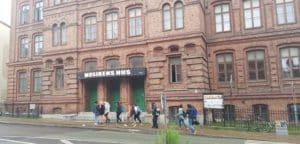
La musikens Hus nous a accueilli pour les masterclass et rencontres avec Abunda.
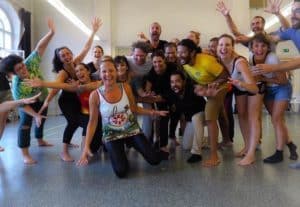
Mais c’est également pendant les soirées et temps informels que nous avons pu continuer à pratiquer et intégrer ces pratiques.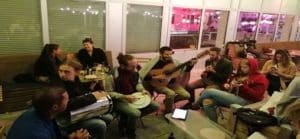
Puis, la semaine c’est poursuivie avec la rencontre de deux autres formations musicales Kiriaka et Caramatu, ce qui nous a permis d’observer des méthodes d’apprentissages différentes et d’entendre les possibilités de créations de ces formations musicales et leurs représentations dans la cité.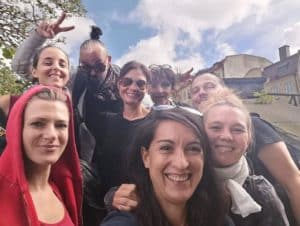
Nous avons donc fait le plein de découvertes, d’apprentissages, de chaleur des échanges avec les personnes rencontrées et du soleil Suédois avant de rentrer le partager à Toulouse avec toute notre association et dans notre environnement personnel.
A gain in transversality…
I was particularly involved in the organisation of the mobility in Porto, for which I was in charge of building the programme of activities and coordinating the groups of participants and international partners. This type of project is particularly interesting because of the combination of skills it requires: artistic and pedagogical skills to define the objectives of the mobility, but also organisational and logistical skills, coordination and animation skills, linguistic skills (two working languages: Portuguese and English).
The Constructeurs de coopérations multiculturelles project acted as a catalyst for the evolution of my professional profile: initially a graduate in musical training, I am progressively acquiring project development skills. I think that this increase in skills and transversality corresponds perfectly to the current evolution of cultural professions, which require more and more versatility and autonomy, in the sense that the cultural actor, artist or pedagogue, is increasingly expected to acquire the skills that allow him to build the spaces and events where he will be able to disseminate and promote his practices.
…Secured by a methodology of cooperation
Obviously, you cannot combine all the skills, and what is interesting is the ability to work across the board while ensuring that each person can at the same time retain and develop their own area of expertise.
This type of project, where the team mobilises and coordinates itself to live an enriching collective experience, is an ideal space to set up or at least refine cooperation methodologies such as the RACI method (responsible, accountable, consulted, informed), which makes it possible to define the role of each person while avoiding the false idea that one must be an expert in everything; This helps to develop a spirit of solidarity and collective responsibility in achieving objectives by avoiding the confinement of each person to his or her own tasks and ignorance of those of others.
The masterclass developed together with Samba Resille, in October 2020, proved to be extremely important for the professional path of Samba Sem Fronteiras.
The musicians that make up the group deal most frequently with the artistic and creative area, involving the creation of new songs, studio recordings and live concerts. In this sense, this masterclass was an excellent opportunity for them to develop skills in transmitting knowledge and experiences, contributing to the integration of the musicians in the educational area and to the improvement of their internal organisation as a working group.
The exchange of experiences with the people from Samba Résille allowed us to realise that each one of them has their own specific vision and “way of being” in music, particularly in samba.
The masterclass was thus a gateway to the development of future projects, in partnership with entities with similar objectives to those of the musicians, also contributing to the dissemination of their work outside Portugal.
——
La masterclass développée en collaboration avec Samba Resille, en octobre 2020, s’est avérée extrêmement importante pour le parcours professionnel de Samba Sem Fronteiras.
Les musiciens qui composent le groupe traitent plus fréquemment du domaine artistique et créatif, impliquant la création de nouvelles musiques, des enregistrements en studio et des concerts en direct. En ce sens, cette masterclass a été une excellente opportunité de développer des compétences de transmission de connaissances et d’expériences, contribuant à l’intégration des musiciens dans le domaine éducatif et à l’amélioration de leur organisation interne en tant que groupe de travail.
L’échange d’expériences avec le personnel de Samba Résille nous a permis de prendre conscience que chacun a sa vision et sa « manière d’être » spécifique en musique, notamment en samba.
La masterclass a ainsi constitué une passerelle pour le développement de futurs projets, en partenariat avec des entités ayant des objectifs similaires à ceux des musiciens, contribuant également à la diffusion de leur travail hors du Portugal.



